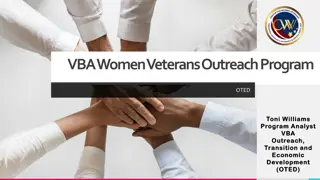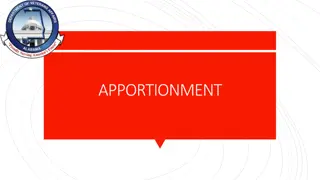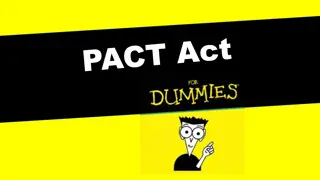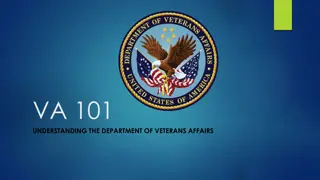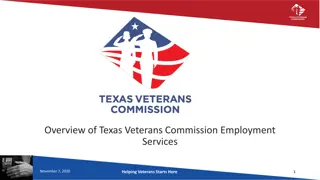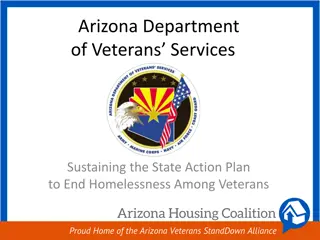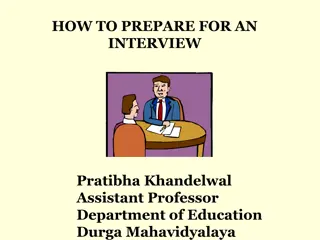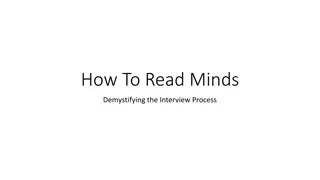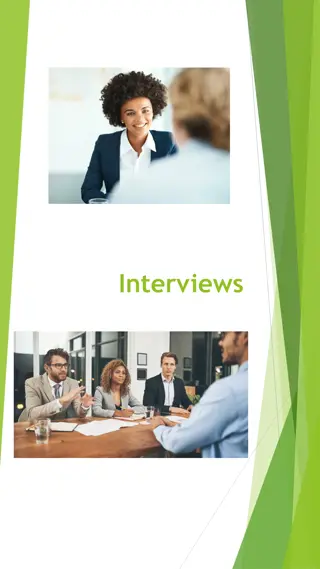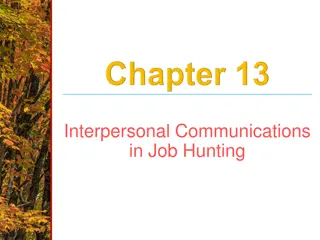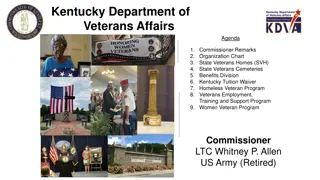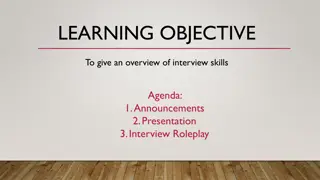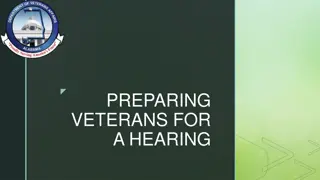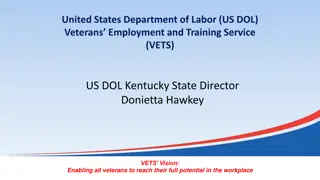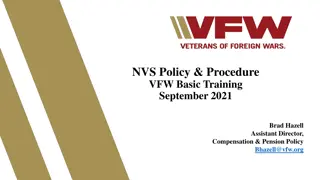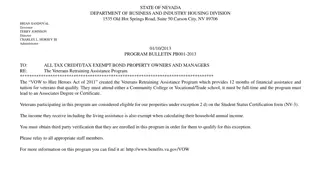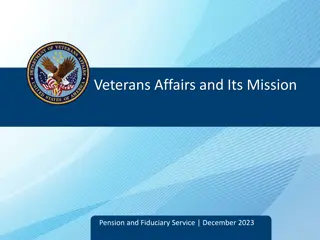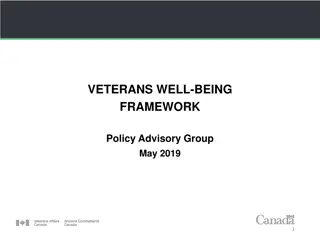Veterans Interview Preparation Guide
Explore the comprehensive guide on conducting successful interviews with veterans. Learn about interview objectives, types, preparation tips, setting up the environment, and more to ensure a positive and effective interaction.
Download Presentation

Please find below an Image/Link to download the presentation.
The content on the website is provided AS IS for your information and personal use only. It may not be sold, licensed, or shared on other websites without obtaining consent from the author. Download presentation by click this link. If you encounter any issues during the download, it is possible that the publisher has removed the file from their server.
E N D
Presentation Transcript
CONDUCTING AN INTERVIEW Gregg Orto Deputy Director, NVS GOrto@vfw.org
OBJECTIVE In this class, we are going to discuss how to prepare for and conduct an interview. 2
PURPOSE Interviews provide both the veteran and the service officer with the necessary information needed to determine what is needed and manage future expectations. 3
TYPES OF INTERVIEWS What are some types of interviews? What is the most common interview used by VFW representatives? 4
PREPARATION What are items a representative should have ready for the intake interview? What should the representative do prior to arrival of a veteran? 5
PREPARATION How do you set up your veteran for success? Did you let them know what to bring? Do you have a checklist you send? How were they referred to your office? What might this tell you if they were referred by the Vet Center? What should you make sure the veteran understands before the initial interview? What is your security like in your building what about parking? 6
ENVIRONMENT Your Attire Dress properly - What is your office dress code? - Shirt Check - Wrinkles? - Collared Shirt? - Does it pass the smell fresh test? 7
ENVIRONMENT - PII Ensure that your office is free of clutter, no personal identifying information (PII) is exposed That last veteran you assisted is that info still on the screen or desk? 8
ENVIRONMENT Office/Desk Is this your desk? What do you see in the photo? Good/bad/improve? Is your client s chair lower than yours? Look at your space from the veteran s point of view Bring in a friend or family member to view your space 9
ENVIRONMENT Bldg layout Know layout of building, emergency protocols and restrooms 10
LIMIT DISRUPTIONS Privacy Do you use an in meeting sign? Are disruptions frequent in your office when you have a client? What do you do about incoming calls? What signal does it send to your veterans if you take a call during the interview? 11
SET THE TONE When setting the tone, consider: Context of meeting Reductions, appeals how pleasant are those? Introduction/greeting Do you greet the veteran when they arrive? Get up from the desk and meet at the door if possible 12
INTRODUCTIONS Introduce yourself to the veteran or claimant Handshake or Fist bump? (COVID-19) Not this Please don t shake someone s fist bump Provide a short intro of your background Allow the veteran or claimant to do the same Common ground helps build rapport Ask the purpose of the visit 13
Representation First form VA 21-22 Are they represented by another VSO? Is there a legitimate reason to switch? Does it need to be updated? How old is the VA 21-22? What has been your experience with older VA 21-22s? What about those who want to switch? 14
Vetraspec Get the basic info into Vetraspec It will help populate forms Don t forget the communications section. This will assist other service officers if you are out and they need to pick up the case or just answer some questions. 15
MAKE SURE YOU ARE UNDERSTOOD Do you understand the words that are coming out of my mouth?! Avoid jargon Let me fire up old Jake the computer and see what s in VBMS I see what you put in SEP, but it s not cested yet Let me get this on a TPS report. The boss wants it on there Consider the client s background, do not condescend You filled out section II on the 674. Did you not read the instructions? Think of VA forms like IRS forms. It s just as foreign to the veteran 16
ACTIVE LISTENING This is difficult Active listening is defined as: Clearly understanding, interpreting, and evaluating the message presented. During an interview, use the following active listening steps: Turn your focus to your customer/your client Let the client talk Listen carefully to what he/she is saying Restate what you heard Allow the client to correct or clarify the information 17
TYPES OF QUESTIONS The question type can influence the level of detail received Close-ended Vs Open-ended Require only short or single word answers Allow for full paragraph answers Require thought before responding Are easy to answer Provide information containing opinions and feelings Provide factual information Keep control of conversation Give control of the conversation 18
IDENTIFY POTENTIAL ELIGIBILITY TO BENEFITS Provide context to questions Instead of Are you married? Do you have children? Explain: Sometimes there are VA benefits available for veterans who have dependents do you have a spouse or children? Listen to conversational cues I see you are retiring from the military in 4 months. Are you staying in the area? Yes, in fact we are looking at purchasing a new home - we re looking to downsize since our kids are all off to college now 20
FLOW OF THE INTERVIEW Records review What was identified by representative Additional items of concern to the veteran Is there anything that is bothering you today that you feel started in the military or was caused by your service? Having a standard order helps avoid confusion during the review What is your order; your rhythm? 21
COMMUNICATING WITH THIRD PARTIES Remember the claim is the client s If a family member is accompanying the client, set expectations of privacy, when they will leave and re-enter If the family member is also a veteran, set a separate appointment to work on their claim Ensure a VA form 21-0845 is signed by client if claim information is to be disclosed to a third party, including Post Service Officers If the veteran/client tells you information should not be divulged to a spouse or other family member, put a note in their VetraSpec file, and never assume 22
HANDLING COMMON COMMUNICATION SITUATIONS How might you handle these situations? Client becomes tearful Client will not listen, persists on same topic Client frequently gets off-topic You do not know how to handle the client s issue 23
HANDLING CRITICISM Agree with the truth/the odds but disagree with the criticism Yes, it will delay your claim but VA is not trying to make you wait on purpose. A new examination will allow you to present new evidence and better support your claim. Set boundaries of what you will and won t accept Broken record restate what you can and can t do Call a time out - reschedule Ask for assistance 24
STRONG EMOTIONS: ALWAYS REMAIN PROFESSIONAL Sometimes veterans come in with baggage At no time do you ever argue with a client. If the client refuses to calm down, kindly ask them to leave or if a phone call, let them know you will need to end the call. What do you do if you cannot de-escalate? What can your office do? Inform the veteran that we reserve the right to revoke our representation if necessary 25
ENDING THE INTERVIEW AND FOLLOWING UP Summarize what was done Give the client a typed list of any homework Suggest a deadline, and how they should submit it (fax, follow up appointment, Email, or submit directly to VA?) Explain the next step in the process and when to follow up Manage expectations Stress timelines 26
ENDING THE INTERVIEW AND FOLLOWING UP Give them your preferred office contact information Thank them for their visit/call, and walk them to the lobby Oh one other thing if you do not have enough time set aside to address the new issue, triage and set up a new appointment, whether it is later that day or another day Add a communication in VetraSpec after every meeting with a brief summary of what took place 27
28 ? s Gregg Orto GOrto@vfw.org


